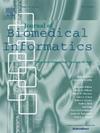Enhanced heart failure mortality prediction through model-independent hybrid feature selection and explainable machine learning
IF 4
2区 医学
Q2 COMPUTER SCIENCE, INTERDISCIPLINARY APPLICATIONS
引用次数: 0
Abstract
Heart failure (HF) remains a significant public health challenge with high mortality rates. Machine learning (ML) techniques offer a promising approach to predict HF mortality, potentially improving clinical outcomes. However, the effectiveness of these techniques heavily depends on the quality and relevance of the features used. This study introduces a novel hybrid feature selection methodology that combines Extremely Randomized Trees (Extra-Trees) and non-linear correlation measures to enhance 1-year all-cause mortality prediction in HF patients using echocardiographic and key demographic data. Unlike existing feature selection methods that are often tied to specific ML models and produce inconsistent feature sets across different algorithms, our proposed approach is model-independent, ensuring robustness and generalizability. Moreover, the optimal number of predictive features is identified through loss graph inspection, leading to a compact and highly informative subset of seven features. We trained and evaluated seven widely-used ML models on both the full feature set and the selected subset, finding that most models maintained or improved their predictive performance despite an 80% reduction in features. Model interpretability was enhanced using SHapley Additive exPlanations (SHAP), allowing for a detailed examination of how individual features influence predictions. To further assess its effectiveness, we compared our methodology against widely known feature selection techniques across all seven ML models. The results underscore the superiority of our proposed feature set in accurately predicting HF mortality over conventional methods, offering new opportunities for personalized management strategies based on a streamlined and explainable feature subset.

通过模型无关的混合特征选择和可解释的机器学习增强心力衰竭死亡率预测
心力衰竭(HF)仍然是一个具有高死亡率的重大公共卫生挑战。机器学习(ML)技术为预测心衰死亡率提供了一种很有前途的方法,有可能改善临床结果。然而,这些技术的有效性在很大程度上取决于所使用特征的质量和相关性。本研究引入了一种新的混合特征选择方法,该方法结合了极端随机树(Extra-Trees)和非线性相关措施,通过超声心动图和关键人口统计学数据来提高心力衰竭患者1年全因死亡率预测。与现有的特征选择方法不同,这些方法通常与特定的ML模型相关联,并且在不同的算法中产生不一致的特征集,我们提出的方法是模型独立的,确保了鲁棒性和泛化性。此外,通过损失图检查确定了预测特征的最佳数量,从而得到了由七个特征组成的紧凑且信息丰富的子集。我们在完整的特征集和选定的子集上训练和评估了七个广泛使用的ML模型,发现尽管特征减少了80%,但大多数模型保持或提高了它们的预测性能。使用SHapley加性解释(SHAP)增强了模型的可解释性,允许详细检查个体特征如何影响预测。为了进一步评估其有效性,我们将我们的方法与所有七个ML模型中广为人知的特征选择技术进行了比较。结果强调了我们提出的特征集在准确预测心衰死亡率方面优于传统方法,为基于简化和可解释的特征子集的个性化管理策略提供了新的机会。
本文章由计算机程序翻译,如有差异,请以英文原文为准。
求助全文
约1分钟内获得全文
求助全文
来源期刊

Journal of Biomedical Informatics
医学-计算机:跨学科应用
CiteScore
8.90
自引率
6.70%
发文量
243
审稿时长
32 days
期刊介绍:
The Journal of Biomedical Informatics reflects a commitment to high-quality original research papers, reviews, and commentaries in the area of biomedical informatics methodology. Although we publish articles motivated by applications in the biomedical sciences (for example, clinical medicine, health care, population health, and translational bioinformatics), the journal emphasizes reports of new methodologies and techniques that have general applicability and that form the basis for the evolving science of biomedical informatics. Articles on medical devices; evaluations of implemented systems (including clinical trials of information technologies); or papers that provide insight into a biological process, a specific disease, or treatment options would generally be more suitable for publication in other venues. Papers on applications of signal processing and image analysis are often more suitable for biomedical engineering journals or other informatics journals, although we do publish papers that emphasize the information management and knowledge representation/modeling issues that arise in the storage and use of biological signals and images. System descriptions are welcome if they illustrate and substantiate the underlying methodology that is the principal focus of the report and an effort is made to address the generalizability and/or range of application of that methodology. Note also that, given the international nature of JBI, papers that deal with specific languages other than English, or with country-specific health systems or approaches, are acceptable for JBI only if they offer generalizable lessons that are relevant to the broad JBI readership, regardless of their country, language, culture, or health system.
 求助内容:
求助内容: 应助结果提醒方式:
应助结果提醒方式:


